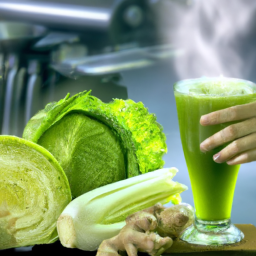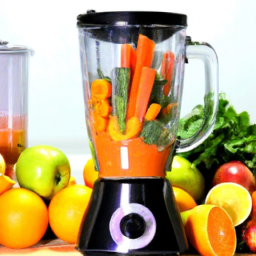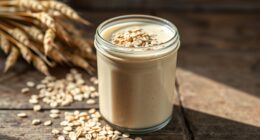Cabbage, part of the cruciferous vegetable group, is known for its crisp texture and slightly bitter flavor. It is a great source of nutrients and antioxidants that can help alleviate symptoms of acid reflux. From my own personal experience dealing with acid reflux for years, I have found that incorporating cabbage juice into my diet has greatly improved how I cope with this condition.
Not only does it have a soothing effect on my stomach, but it also promotes healthy digestion and reduces inflammation.
Acid reflux, also known as gastroesophageal reflux disease (GERD), is a common condition that affects millions of people worldwide. It occurs when the lower esophageal sphincter (LES), the muscle that separates the esophagus from the stomach, fails to close properly, allowing stomach acid to flow back into the esophagus and cause irritation.
This can lead to a range of uncomfortable symptoms, including heartburn, regurgitation, bloating, and nausea. In this article, I will share with you my experience of making cabbage juice for acid reflux and how it has helped me manage my symptoms.
Key Takeaways
- Cabbage is a natural remedy that can alleviate acid reflux symptoms due to its nutrients and antioxidants.
- Proper techniques are required to cut and juice cabbage to maximize the yield of juice and nutrients.
- Adding lemon, ginger, apple cider vinegar, pineapple, or mint to cabbage juice can enhance its flavor and provide additional health benefits.
- Incorporating cabbage juice into the diet can improve digestion, reduce inflammation, and increase immunity, but it’s important to consult with a doctor or registered dietitian before doing so.
Understanding Acid Reflux
You’ll want to understand the mechanics of acid reflux before attempting to make cabbage juice to alleviate your symptoms.
Acid reflux, also known as gastroesophageal reflux disease (GERD), occurs when stomach acid flows back into the esophagus.
The symptoms of acid reflux can include heartburn, regurgitation of food or liquid, difficulty swallowing, and chest pain.
There are several causes of acid reflux, including obesity, a hiatal hernia, pregnancy, smoking, and eating large meals or certain types of food.
While cabbage juice is a natural remedy for acid reflux, there are other options available.
Ginger, apple cider vinegar, and chamomile tea are also known to alleviate symptoms.
It’s important to note that while natural remedies can be helpful, they may not work for everyone.
In some cases, medication or surgery may be necessary.
Now that you understand acid reflux and the natural remedies available, let’s move on to choosing and preparing cabbage.
Choosing and Preparing Cabbage
When it comes to preparing cabbage for juicing, there are a few key points to keep in mind.
First, there are various types of cabbage to choose from, including green, red, and savoy.
Second, selecting and cleaning cabbage is important to ensure that it’s free of dirt and debris.
Lastly, cutting and juicing cabbage requires proper techniques to maximize the yield of juice and nutrients.
As I prepare to make cabbage juice for acid reflux, I’m mindful of these important steps to ensure a healthy and delicious drink.
Types of Cabbage
There’s a wide variety of cabbage types available for making your own acid reflux-healing juice. Here are four of the most popular types of cabbage that you can use:
-
Green cabbage – This is the most common type of cabbage and is easily found in most grocery stores. It has a slightly sweet flavor and is perfect for making cabbage juice for acid reflux.
-
Red cabbage – Also known as purple cabbage, this type of cabbage is rich in antioxidants and has a slightly bitter taste. It’s a great option for those who want a more colorful and flavorful juice.
-
Napa cabbage – This type of cabbage has a milder flavor than other types and is often used in Asian cuisine. It has a delicate texture and is perfect for making a lighter cabbage juice.
-
Savoy cabbage – This type of cabbage has crinkly leaves and a sweeter taste than other types. It’s a great option for those who want a sweeter juice without adding any additional sweeteners.
When choosing your cabbage, it’s important to select fresh, firm heads and clean them thoroughly.
Selecting and Cleaning Cabbage
To ensure a delicious and healthy juice, it’s crucial that you carefully select and clean your fresh cabbage.
When selecting cabbage, look for heads that are firm and heavy for their size. Avoid cabbage with wilted or damaged leaves, as this may indicate decay or insect damage. Additionally, choose cabbage that has a vibrant green color, as this indicates freshness.
Once you have selected your cabbage, it’s important to thoroughly clean it before juicing. Start by removing any damaged or wilted outer leaves. Then, rinse the head of cabbage under cold running water, making sure to remove any dirt or debris that may be stuck between the leaves.
Once your cabbage is clean, you are ready to move on to the next step of cutting and juicing.
Cutting and Juicing Cabbage
Before diving into the cutting and juicing process, it’s important to remember that the quality of your cabbage and the techniques you use can greatly impact the taste and health benefits of your final product. To ensure that you get the best cabbage juice possible, start by selecting a fresh and organic cabbage. Then, rinse it thoroughly under running water to remove any dirt or debris that may be present on the surface.
Once you have your cabbage ready, the next step is to cut it into small pieces that can easily fit into your juicing equipment. A simple way to do this is by using a sharp knife to slice the cabbage in half, then quarter it, and finally cut it into smaller pieces. Alternatively, you can also use a food processor to chop the cabbage into fine pieces. Once you have your cabbage cut, feed it into the juicer and extract the juice. Drinking cabbage juice regularly can provide you with a host of benefits, including improved digestion, reduced inflammation, and increased immunity.
To enhance the flavor and benefits of cabbage juice, you can add other fruits and vegetables to the mix. In the next section, I’ll share some tips on how to combine cabbage juice with other ingredients to create delicious and nutritious beverages that can help alleviate acid reflux symptoms.
Enhancing the Flavor and Benefits of Cabbage Juice
Adding a splash of lemon or ginger to your cabbage juice can not only enhance its flavor but also provide additional health benefits, like reducing inflammation and aiding digestion. Here are some variations of cabbage juice recipes that you can try to incorporate into your diet:
-
Lemon and Cabbage Juice: Squeeze half a lemon into a cup of cabbage juice and stir well. Lemon is a natural detoxifier and can help improve digestion.
-
Ginger and Cabbage Juice: Add a thumb-sized piece of ginger to your cabbage juice before blending. Ginger has anti-inflammatory properties and can help ease nausea and indigestion.
-
Apple Cider Vinegar and Cabbage Juice: Add a tablespoon of apple cider vinegar to your cabbage juice for a tangy taste. Apple cider vinegar is known for its ability to balance the pH level in the body and improve gut health.
-
Pineapple and Cabbage Juice: Blend one cup of chopped pineapple with one cup of cabbage for a tropical twist. Pineapple contains an enzyme called bromelain, which can help reduce inflammation and improve digestion.
-
Mint and Cabbage Juice: Add a handful of fresh mint leaves to your cabbage juice for a refreshing taste. Mint can help relax the muscles in the digestive tract and ease bloating.
Incorporating cabbage juice into your diet can be a great way to improve your overall health. But before you start drinking it regularly, it’s important to consult with your doctor or a registered dietitian to make sure it’s safe and won’t interfere with any medications you’re taking.
Incorporating Cabbage Juice into Your Diet
Incorporating cabbage juice into your daily routine can be a fun and tasty way to boost your overall health and wellness. Not only is cabbage low in calories and high in fiber, but it also contains a variety of vitamins and minerals that your body needs to function properly. Additionally, cabbage has been shown to have numerous health benefits, including reducing inflammation and improving digestion.
One easy way to incorporate cabbage juice into your diet is by adding it to smoothies or juices. For example, you could blend cabbage with other fruits and vegetables, such as apples, carrots, and ginger, for a delicious and nutrient-packed drink. You could also try incorporating cabbage into your meals by adding it to salads, stir-fries, or soups. There are plenty of recipes with cabbage out there, so don’t be afraid to get creative with your cooking!
As you continue to explore natural remedies for acid reflux, it’s important to remember that there are many different options available. While cabbage juice can be a great choice, it may not be the right solution for everyone. Keep an open mind and be willing to try different approaches until you find the one that works best for your unique needs and preferences.
Other Natural Remedies for Acid Reflux
If you’re looking for alternative ways to alleviate heartburn and indigestion, there are several natural remedies worth exploring. Here are five herbal remedies that may help:
-
Ginger: Known for its anti-inflammatory properties, ginger can help reduce inflammation in the esophagus and stomach. It can be consumed in tea form, as a supplement, or even added to meals.
-
Slippery elm: This herb contains mucilage, which can coat and soothe the esophagus and stomach. It can be taken in supplement form or made into a tea.
-
Chamomile: A popular herb known for its calming effects, chamomile can also help reduce inflammation and irritation in the digestive tract. It can be consumed in tea form.
-
Licorice root: This herb can help soothe the lining of the stomach and esophagus, as well as reduce inflammation. It can be taken as a supplement or consumed in tea form.
-
Peppermint: Although peppermint can sometimes aggravate acid reflux symptoms, it can also help relax the muscles in the digestive tract and reduce inflammation. It can be consumed in tea form or as a supplement.
In addition to herbal remedies, making certain dietary changes may also help alleviate acid reflux symptoms. These include avoiding trigger foods like spicy or acidic foods, eating smaller meals more frequently throughout the day, and avoiding lying down immediately after eating.
Now, let’s explore some lifestyle changes for managing acid reflux.
Lifestyle Changes for Managing Acid Reflux
One simple way to manage acid reflux is by changing daily habits. Dietary modifications, such as avoiding trigger foods like caffeine, alcohol, and spicy foods, can help prevent acid reflux symptoms from occurring.
It’s also important to eat smaller meals more frequently throughout the day rather than one large meal. This can help prevent the stomach from becoming too full and putting pressure on the lower esophageal sphincter, which can cause acid reflux.
Stress management techniques can also be helpful in managing acid reflux. Stress has been shown to increase acid production in the stomach, which can exacerbate symptoms. Techniques such as deep breathing, meditation, and exercise can help reduce stress and lessen the likelihood of experiencing acid reflux symptoms.
By making these simple lifestyle changes, you may be able to manage your acid reflux without the need for medical intervention. However, if symptoms persist, it’s important to seek medical help.
When to Seek Medical Help
As someone who suffers from acid reflux, it’s important to be aware of warning signs of complications and when to seek medical help.
If you experience difficulty swallowing, persistent vomiting, or unintentional weight loss, it might be time to consult with a healthcare provider.
In some cases, prescription medications may be necessary to manage symptoms and prevent further complications.
Warning Signs of Complications
Beware of potential complications and take action to prevent them, because acid reflux can seriously impact your quality of life. While acid reflux may seem like a minor inconvenience, it can lead to serious complications if left untreated.
One of the most common complications is GERD, or gastroesophageal reflux disease. This condition occurs when stomach acid repeatedly flows back into the esophagus, causing inflammation and damage to the lining of the esophagus. Over time, GERD can lead to esophageal ulcers, strictures, and even cancer of the esophagus.
Fortunately, there are warning signs that can alert you to potential complications. If you experience persistent heartburn, difficulty swallowing, or chest pain, it’s important to seek medical attention right away.
Additionally, if you’re using cabbage juice to treat your acid reflux and you notice any unusual symptoms, such as nausea, vomiting, or diarrhea, it’s important to stop using the juice and consult with a healthcare provider.
By taking action to prevent complications and seeking medical help when necessary, you can manage your acid reflux and improve your quality of life.
Consultation with a Healthcare Provider
As I mentioned earlier, warning signs of complications with acid reflux can include difficulty swallowing, chest pain, and vomiting blood. If you experience any of these symptoms, it’s important to seek medical attention immediately. However, even if you don’t experience any warning signs, it’s still important to consult with a healthcare provider before starting a new treatment plan, such as drinking cabbage juice for acid reflux.
Consultation with a healthcare provider is crucial for proper acid reflux diagnosis and treatment. Your healthcare provider can perform diagnostic tests, such as an endoscopy or pH monitoring, to determine the severity of your acid reflux and rule out any other underlying conditions. They can also help you develop a personalized treatment plan that takes into account your specific symptoms and medical history.
By seeking the guidance of a healthcare professional, you can ensure that you’re taking the safest and most effective steps towards managing your acid reflux.
- What to expect during a healthcare provider consultation
- Importance of sharing your medical history
- Common diagnostic tests for acid reflux
- Treatment options beyond cabbage juice
- Questions to ask your healthcare provider during the consultation
Now that we’ve discussed the importance of consulting with a healthcare provider, let’s move on to the next step in managing acid reflux: prescription medications.
Prescription Medications
Prescription medications can be a game-changer for those struggling with persistent symptoms of GERD. Proton pump inhibitors (PPIs) are the most common type of medication prescribed for acid reflux. Studies show that up to 80% of patients see improvement with their use.
PPIs work by blocking the production of acid in the stomach, which can help relieve symptoms such as heartburn, regurgitation, and difficulty swallowing. Despite their effectiveness, PPIs are not without side effects. Some of the most common side effects include headaches, diarrhea, nausea, and abdominal pain.
Long-term use of these medications has also been associated with an increased risk of bone fractures, kidney disease, and infections such as pneumonia. For this reason, it’s important to consult with your healthcare provider before starting any medication and to weigh the benefits against the potential risks.
As effective as medication alternatives may be, some people prefer to explore natural remedies for their acid reflux. In the next section, I’ll share my personal experiences with cabbage juice and how it’s helped me manage my symptoms.
Personal Experiences with Cabbage Juice
In my personal experience, cabbage juice has been a game changer in managing my acid reflux symptoms. I’ve heard many success stories from others who’ve also found relief by incorporating cabbage juice into their diet.
However, I’ve faced some challenges and limitations in making it a regular habit. Through trial and error, I’ve learned some tips for making cabbage juice a sustainable and enjoyable part of my routine.
Success Stories
You’ll love hearing about how others have found relief from acid reflux by drinking cabbage juice. There are many inspiring testimonials out there, with people sharing their unexpected results from incorporating cabbage juice into their daily routine.
One person shared that they had been suffering from acid reflux for years and tried countless medications with no luck. But after drinking cabbage juice for just a few days, they noticed a significant decrease in their symptoms. Another person shared that they had been able to wean off of their medication completely after consistently drinking cabbage juice for a few weeks.
These success stories are not just anecdotal, as there is science behind the benefits of cabbage juice for acid reflux. Cabbage is high in compounds called glutamine and S-methylmethionine, which have been shown to help heal the lining of the stomach and reduce inflammation. Additionally, cabbage is a good source of vitamin C, which may also help reduce inflammation in the digestive tract.
Incorporating cabbage juice into your diet may not only provide relief from acid reflux, but also provide other health benefits. However, it’s important to note that everyone’s experience may vary and it’s best to consult with a healthcare professional before making any changes to your treatment plan.
Moving into the subsequent section about challenges and limitations, it’s important to recognize that while cabbage juice may provide relief for some people, it may not work for everyone. Additionally, some people may not enjoy the taste of cabbage juice or may experience digestive discomfort from consuming large amounts of raw cabbage.
It’s also important to note that cabbage juice should not be used as a replacement for medication prescribed by a healthcare professional. As with any treatment plan, it’s best to work with a healthcare professional to find the best approach for your individual needs.
Challenges and Limitations
But don’t worry, if you’re not a fan of the taste of raw cabbage, there are other ways to incorporate this superfood into your diet.
One of the biggest challenges that people face when trying to make cabbage juice for acid reflux is the taste. Let’s face it, cabbage juice is not the most appetizing drink out there, and some people find the taste to be unbearable.
However, there are a few alternatives that you can try. One option is to mix the cabbage juice with other fruits and vegetables to make it more palatable. For example, you can add some apple or carrot juice to your cabbage juice to make it sweeter.
Another option is to add some spices like ginger or turmeric to your cabbage juice to give it a little bit of a kick. With a little experimentation, you can find a recipe that works for you and makes drinking cabbage juice a habit.
Tips for making cabbage juice a habit will be discussed in the next section.
Tips for Making Cabbage Juice a Habit
Although there are challenges and limitations in incorporating cabbage juice into your diet, it’s important to keep in mind that it can greatly benefit those suffering from acid reflux. With its anti-inflammatory properties and ability to soothe the digestive tract, cabbage juice has been shown to improve symptoms and promote better overall health.
However, making cabbage juice a habit can be easier said than done. Here are some tips to help you make cabbage juice a regular part of your diet and reap its potential benefits:
- Start small: Begin by drinking a small amount of cabbage juice each day and gradually increase the amount as your body gets used to it.
- Mix it up: Experiment with adding different fruits and vegetables to your cabbage juice to make it more enjoyable and varied.
- Stay consistent: Try to drink cabbage juice at the same time each day to establish a routine and make it easier to remember.
- Invest in a good juicer: A high-quality juicer can make the process of juicing cabbage much easier and more efficient.
- Educate yourself: Learn more about the health benefits of cabbage juice and how it can improve your overall well-being.
Incorporating healthy habits like drinking cabbage juice into your daily routine can be challenging, but it’s important to stay motivated and committed to improving your health. With the right mindset and strategies, you can make cabbage juice a habit and experience its potential benefits for acid reflux and overall wellness.
Frequently Asked Questions
Can I use any type of cabbage for making juice?
I recommend using green cabbage for acid reflux juice because it has higher alkaline content. To prepare the leaves for juicing, remove the tough outer layers, chop them into small pieces, and blend with water.
How long does it take to see results from drinking cabbage juice for acid reflux?
Results from drinking cabbage juice for acid reflux vary, but benefits beyond digestion include improved immune function and reduced inflammation. To incorporate into daily routine, start with small amounts and gradually increase.
Can I add other ingredients to my cabbage juice for flavor?
Yes, I enjoy experimenting with juice variations to add flavor and enhance the health benefits. However, it’s important to consider the potential interactions between ingredients and their impact on digestion.
How often should I drink cabbage juice for acid reflux?
To get the most benefit from cabbage juice for acid reflux, I recommend drinking it twice a day, before meals. This frequency has been shown to improve symptoms. However, consult with your healthcare provider before starting any new treatment regimen.
Are there any potential side effects of drinking cabbage juice for acid reflux?
As with any dietary change, there are potential risks and contraindications to consider when drinking cabbage juice for acid reflux. These may include digestive discomfort, gas, and bloating. It’s important to consult with a healthcare provider before starting a new regimen.
Conclusion
Well folks, that’s a wrap! I hope this article has been helpful in guiding you through the process of making cabbage juice for acid reflux.
Remember, while cabbage juice has been shown to alleviate symptoms, it’s important to also make lifestyle changes and seek medical help if necessary.
In the end, it’s all about finding what works best for you and your body. Don’t be afraid to experiment with different natural remedies and see what gives you the relief you need.
And who knows, maybe you’ll even become a fan of cabbage juice – it might just become your new favorite drink! Cheers to good health and happy juicing!
Ilana has been a vegan for over 10 years. She originally made the switch for health reasons, but soon found herself becoming more and more passionate about the ethical and environmental implications of a vegan lifestyle. Ilana is the author of The Graceful Kitchen, a blog all about veganism. She loves to cook up delicious and nutritious vegan meals, and share her recipes with others who are interested in leading a cruelty-free life. Ilana is also a strong advocate for using whole foods as the foundation of a healthy diet, and believes that going vegan is one of the best ways to achieve this.










